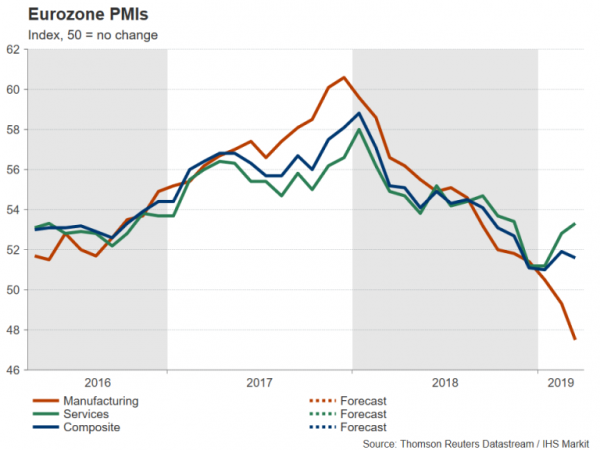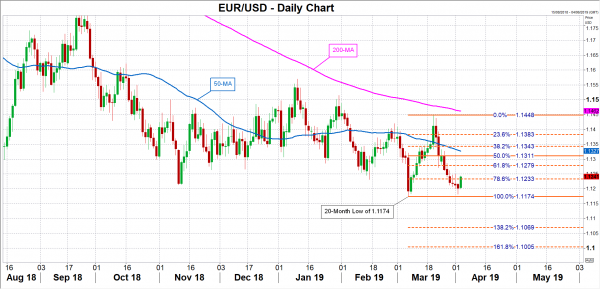The euro is trading near its 2019 lows as not even a more dovish Fed has been able to offset any of the gloomy Eurozone outlook from weighing on the single currency. The continent’s deepening economic slowdown finally has the European Central Bank worried, deciding to take action at its March policy meeting to further stimulate the economy. The account of that meeting is due to be published on Thursday at 11:30 GMT and could reveal whether policymakers discussed any additional measures to those already announced.
At the end of its two-day monetary policy meeting on March 7, the ECB confirmed market speculation of a new round of cheap loans for banks by announcing TLTRO-III (targeted longer-term refinancing operations). However, the Bank went one step further and also revised its forward guidance, pushing back the expected timing of a hike in its key interest rates to 2020, having previously signalled a rate increase in the autumn of this year.
The euro dropped to a 20-month low of $1.1174 following the ECB’s decision and has struggled to gain fresh upside momentum since in the absence of any positive economic indicators and more dovish voices coming from the central bank. Brexit and trade uncertainty having been taking a toll on European manufacturers, particularly in the bloc’s powerhouse – Germany. The closely-watched IHS Markit manufacturing PMI for the Eurozone slumped to a 6-year low of 47.5 in March, although the services PMI provided some hope of a turnaround as it rose for a second straight month.
The continued weakness forced the ECB to lower its macroeconomic projections in March for the euro area. The Bank now expects growth of just 1.1% year-on-year in 2019 versus forecasts 1.7% y/y in its December projections. Inflation meanwhile is expected to average 1.2% y/y compared with prior forecasts of 1.6% y/y.
ECB President Mario Draghi has suggested that should the inflation outlook deteriorate further, the forward guidance on rates could be adjusted again, in a major dovish signal. It should be noted, though, that given Draghi’s term expires at the end of October, making further changes to the forward guidance would probably be difficult until a new president has been appointed.
In another dovish sign, the ECB has said it is studying options of introducing a tiered system for its deposit rate, which, at -0.40%, is hurting banks’ profitability. Exempting banks from being charged a fee on some of their excess cash deposited at the ECB could ease some of the side effects from negative rates on the Eurozone’s banking system.
Other central banks with negative rates, such as the Bank of Japan and Switzerland, already have a tiered structure to mitigate the impact of negative rates. However, while such a policy may relieve cost pressures on commercial banks, it also sends out a message that negative rates are here to stay. Consequently, the euro has been edging lower since the reports on a tiered deposit rate started circulating.
The ECB’s March meeting minutes are unlikely to include such discussions yet but may indicate whether Governing Council members were swaying towards taking further policy steps to counter the slowdown. Dovish minutes would likely push the euro below the 2019 low of $1.1174. A break below this key support region could set the stage for further declines in the short-to-medium term. Key supports below the $1.11 handle could come at the 138.2% and 161.8% Fibonacci extensions of the upleg from $1.1174 to $1.1448, at $1.1070 and $1.1005 respectively.
In the event that the minutes surprise by policymakers expressing confidence that the resilience of domestic demand would be enough to stave off a sharper downturn, the euro could see a modest upside. The single currency could initially climb towards the 61.8% Fibonacci around $1.1280 before aiming for the 50% Fibonacci around $1.1310.
Looking at the euro’s prospects in the months ahead, a resolution to the US-China trade dispute as well as an end to the Brexit deadlock in the UK are key in lifting business sentiment in the region and could help trigger a rebound in economic growth. Without an external boost, however, it’s hard to envision a substantial recovery in the Eurozone given the limited tools the ECB has at its disposal.














